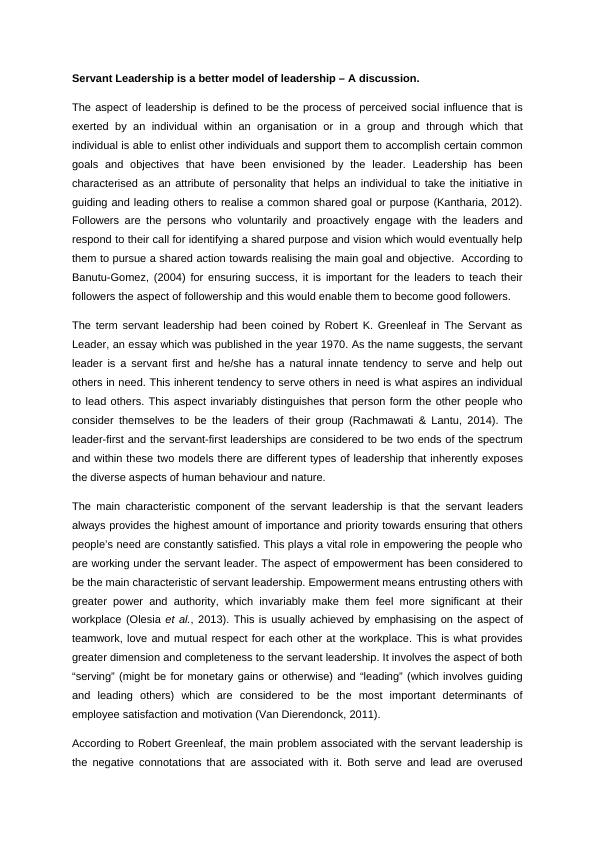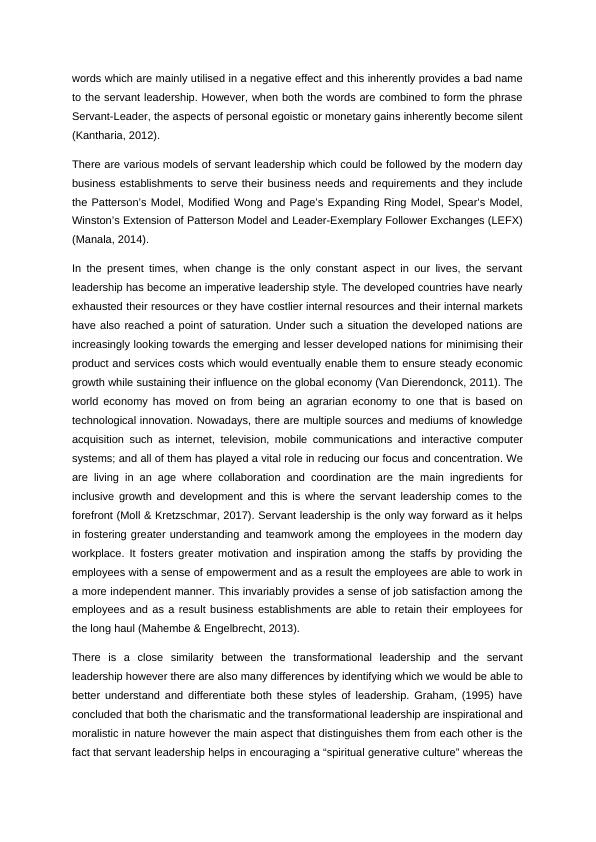Servant Leadership is a Better Model of Leadership - A Discussion
Added on 2023-06-04
7 Pages2770 Words408 Views
Servant Leadership is a better model
of leadership – A discussion.
of leadership – A discussion.

Servant Leadership is a better model of leadership – A discussion.
The aspect of leadership is defined to be the process of perceived social influence that is
exerted by an individual within an organisation or in a group and through which that
individual is able to enlist other individuals and support them to accomplish certain common
goals and objectives that have been envisioned by the leader. Leadership has been
characterised as an attribute of personality that helps an individual to take the initiative in
guiding and leading others to realise a common shared goal or purpose (Kantharia, 2012).
Followers are the persons who voluntarily and proactively engage with the leaders and
respond to their call for identifying a shared purpose and vision which would eventually help
them to pursue a shared action towards realising the main goal and objective. According to
Banutu-Gomez, (2004) for ensuring success, it is important for the leaders to teach their
followers the aspect of followership and this would enable them to become good followers.
The term servant leadership had been coined by Robert K. Greenleaf in The Servant as
Leader, an essay which was published in the year 1970. As the name suggests, the servant
leader is a servant first and he/she has a natural innate tendency to serve and help out
others in need. This inherent tendency to serve others in need is what aspires an individual
to lead others. This aspect invariably distinguishes that person form the other people who
consider themselves to be the leaders of their group (Rachmawati & Lantu, 2014). The
leader-first and the servant-first leaderships are considered to be two ends of the spectrum
and within these two models there are different types of leadership that inherently exposes
the diverse aspects of human behaviour and nature.
The main characteristic component of the servant leadership is that the servant leaders
always provides the highest amount of importance and priority towards ensuring that others
people’s need are constantly satisfied. This plays a vital role in empowering the people who
are working under the servant leader. The aspect of empowerment has been considered to
be the main characteristic of servant leadership. Empowerment means entrusting others with
greater power and authority, which invariably make them feel more significant at their
workplace (Olesia et al., 2013). This is usually achieved by emphasising on the aspect of
teamwork, love and mutual respect for each other at the workplace. This is what provides
greater dimension and completeness to the servant leadership. It involves the aspect of both
“serving” (might be for monetary gains or otherwise) and “leading” (which involves guiding
and leading others) which are considered to be the most important determinants of
employee satisfaction and motivation (Van Dierendonck, 2011).
According to Robert Greenleaf, the main problem associated with the servant leadership is
the negative connotations that are associated with it. Both serve and lead are overused
The aspect of leadership is defined to be the process of perceived social influence that is
exerted by an individual within an organisation or in a group and through which that
individual is able to enlist other individuals and support them to accomplish certain common
goals and objectives that have been envisioned by the leader. Leadership has been
characterised as an attribute of personality that helps an individual to take the initiative in
guiding and leading others to realise a common shared goal or purpose (Kantharia, 2012).
Followers are the persons who voluntarily and proactively engage with the leaders and
respond to their call for identifying a shared purpose and vision which would eventually help
them to pursue a shared action towards realising the main goal and objective. According to
Banutu-Gomez, (2004) for ensuring success, it is important for the leaders to teach their
followers the aspect of followership and this would enable them to become good followers.
The term servant leadership had been coined by Robert K. Greenleaf in The Servant as
Leader, an essay which was published in the year 1970. As the name suggests, the servant
leader is a servant first and he/she has a natural innate tendency to serve and help out
others in need. This inherent tendency to serve others in need is what aspires an individual
to lead others. This aspect invariably distinguishes that person form the other people who
consider themselves to be the leaders of their group (Rachmawati & Lantu, 2014). The
leader-first and the servant-first leaderships are considered to be two ends of the spectrum
and within these two models there are different types of leadership that inherently exposes
the diverse aspects of human behaviour and nature.
The main characteristic component of the servant leadership is that the servant leaders
always provides the highest amount of importance and priority towards ensuring that others
people’s need are constantly satisfied. This plays a vital role in empowering the people who
are working under the servant leader. The aspect of empowerment has been considered to
be the main characteristic of servant leadership. Empowerment means entrusting others with
greater power and authority, which invariably make them feel more significant at their
workplace (Olesia et al., 2013). This is usually achieved by emphasising on the aspect of
teamwork, love and mutual respect for each other at the workplace. This is what provides
greater dimension and completeness to the servant leadership. It involves the aspect of both
“serving” (might be for monetary gains or otherwise) and “leading” (which involves guiding
and leading others) which are considered to be the most important determinants of
employee satisfaction and motivation (Van Dierendonck, 2011).
According to Robert Greenleaf, the main problem associated with the servant leadership is
the negative connotations that are associated with it. Both serve and lead are overused

words which are mainly utilised in a negative effect and this inherently provides a bad name
to the servant leadership. However, when both the words are combined to form the phrase
Servant-Leader, the aspects of personal egoistic or monetary gains inherently become silent
(Kantharia, 2012).
There are various models of servant leadership which could be followed by the modern day
business establishments to serve their business needs and requirements and they include
the Patterson’s Model, Modified Wong and Page’s Expanding Ring Model, Spear’s Model,
Winston’s Extension of Patterson Model and Leader-Exemplary Follower Exchanges (LEFX)
(Manala, 2014).
In the present times, when change is the only constant aspect in our lives, the servant
leadership has become an imperative leadership style. The developed countries have nearly
exhausted their resources or they have costlier internal resources and their internal markets
have also reached a point of saturation. Under such a situation the developed nations are
increasingly looking towards the emerging and lesser developed nations for minimising their
product and services costs which would eventually enable them to ensure steady economic
growth while sustaining their influence on the global economy (Van Dierendonck, 2011). The
world economy has moved on from being an agrarian economy to one that is based on
technological innovation. Nowadays, there are multiple sources and mediums of knowledge
acquisition such as internet, television, mobile communications and interactive computer
systems; and all of them has played a vital role in reducing our focus and concentration. We
are living in an age where collaboration and coordination are the main ingredients for
inclusive growth and development and this is where the servant leadership comes to the
forefront (Moll & Kretzschmar, 2017). Servant leadership is the only way forward as it helps
in fostering greater understanding and teamwork among the employees in the modern day
workplace. It fosters greater motivation and inspiration among the staffs by providing the
employees with a sense of empowerment and as a result the employees are able to work in
a more independent manner. This invariably provides a sense of job satisfaction among the
employees and as a result business establishments are able to retain their employees for
the long haul (Mahembe & Engelbrecht, 2013).
There is a close similarity between the transformational leadership and the servant
leadership however there are also many differences by identifying which we would be able to
better understand and differentiate both these styles of leadership. Graham, (1995) have
concluded that both the charismatic and the transformational leadership are inspirational and
moralistic in nature however the main aspect that distinguishes them from each other is the
fact that servant leadership helps in encouraging a “spiritual generative culture” whereas the
to the servant leadership. However, when both the words are combined to form the phrase
Servant-Leader, the aspects of personal egoistic or monetary gains inherently become silent
(Kantharia, 2012).
There are various models of servant leadership which could be followed by the modern day
business establishments to serve their business needs and requirements and they include
the Patterson’s Model, Modified Wong and Page’s Expanding Ring Model, Spear’s Model,
Winston’s Extension of Patterson Model and Leader-Exemplary Follower Exchanges (LEFX)
(Manala, 2014).
In the present times, when change is the only constant aspect in our lives, the servant
leadership has become an imperative leadership style. The developed countries have nearly
exhausted their resources or they have costlier internal resources and their internal markets
have also reached a point of saturation. Under such a situation the developed nations are
increasingly looking towards the emerging and lesser developed nations for minimising their
product and services costs which would eventually enable them to ensure steady economic
growth while sustaining their influence on the global economy (Van Dierendonck, 2011). The
world economy has moved on from being an agrarian economy to one that is based on
technological innovation. Nowadays, there are multiple sources and mediums of knowledge
acquisition such as internet, television, mobile communications and interactive computer
systems; and all of them has played a vital role in reducing our focus and concentration. We
are living in an age where collaboration and coordination are the main ingredients for
inclusive growth and development and this is where the servant leadership comes to the
forefront (Moll & Kretzschmar, 2017). Servant leadership is the only way forward as it helps
in fostering greater understanding and teamwork among the employees in the modern day
workplace. It fosters greater motivation and inspiration among the staffs by providing the
employees with a sense of empowerment and as a result the employees are able to work in
a more independent manner. This invariably provides a sense of job satisfaction among the
employees and as a result business establishments are able to retain their employees for
the long haul (Mahembe & Engelbrecht, 2013).
There is a close similarity between the transformational leadership and the servant
leadership however there are also many differences by identifying which we would be able to
better understand and differentiate both these styles of leadership. Graham, (1995) have
concluded that both the charismatic and the transformational leadership are inspirational and
moralistic in nature however the main aspect that distinguishes them from each other is the
fact that servant leadership helps in encouraging a “spiritual generative culture” whereas the

End of preview
Want to access all the pages? Upload your documents or become a member.
Related Documents
Leadership and its Critical Analysislg...
|15
|5312
|26
Advantages and Disadvantages of Servant Leadership Management Stylelg...
|7
|2152
|147
Servant Leadership | Organizations and Leadershiplg...
|11
|3161
|30
What Is Organizational Leadership and Why Is It Important?lg...
|6
|1356
|14
Comparison of Servant Leadership and Authentic Leadership Styleslg...
|9
|2679
|358
Servant Leadership: Characteristics, Pros and Conslg...
|7
|2264
|73